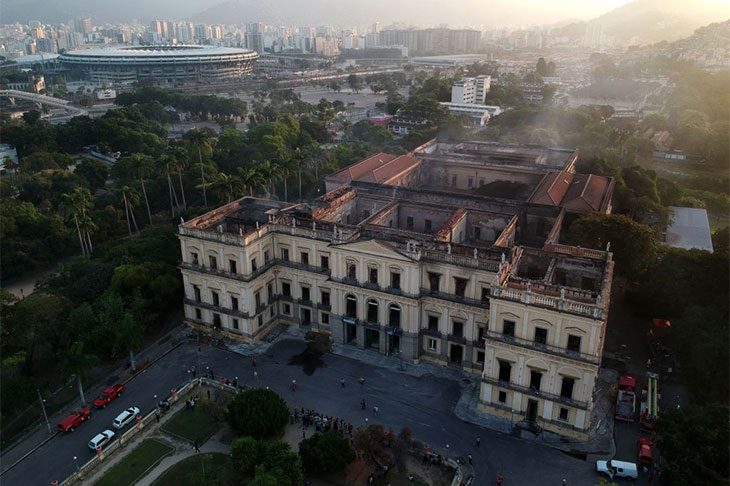In 1808, a canny merchant named Elias António Lopes presented his expansive villa on the outskirts of Rio de Janeiro, known as the Quinta da Boa Vista, to the recently arrived Portuguese prince regent, Dom João. The prince regent gladly accepted the offer. His flight to Brazil from Napoleon’s advancing armies had forced him into uncomfortable proximity with his dreaded wife, Dona Carlota. At Quinta da Boa Vista, he could resume the solitary splendour he had enjoyed in the cavernous palace-monastery of Mafra, near Lisbon. Lopes was duly rewarded for his troubles with a knighthood and an office at court.
It was by way of the royal family and its marital tribulations that the Quinta da Boa Vista became home to the National Museum of Brazil. A decade after reaching Brazil, and precisely two hundred years ago, Dom João began the country’s first natural history collection, housed first in the city centre. But it was principally under his heirs that the project took flight. His eldest son Dom Pedro was little drawn to scholarly pursuits, but his unloved bride, Archduchess Leopoldina of Austria, proved a prodigious godmother to the sciences, immersing herself in the study of Brazilian geology, fauna and flora, and bringing with her to Rio a posse of scientists and naturalists who ventured deep into the interior of the country, sending specimens back to Rio.
With Brazil’s declaration of independence from Portugal in 1822, the task of charting the country’s natural history received a new impetus. Dom Pedro, newly crowned as emperor, wished to be seen as no mere Portuguese transplant, but as a Brazilian to his bones. Under the auspices of his chief minister, José Bonifácio de Andrada – notably, a geologist by training – royal iconography began to take in the land, its immense biodiversity and its native peoples. The collection of items illuminating the country’s natural history took on a commensurate importance.
Emperor Pedro II of Brazil (c. 1887), Alphonse Liébert. Image: Wikimedia Commons (public domain)
Dom Pedro’s son and heir, Emperor Pedro II, proved very much his mother’s son and his tutor José Bonifácio’s protégé. ‘I was born to dedicate myself to letters and to the sciences’, he wrote, and he styled himself accordingly, dressing in plain clothes and growing a long, bushy beard. Indifferent to the trappings of monarchy, he installed a laboratory and observatory at the Quinta da Boa Vista and devoted himself to augmenting the national collection, adding a huge number of paleontological, ethnographic and archaeological items from Brazil and elsewhere, while also developing a private museum at the palace. For the emperor, science meant progress, and it was only through progress that Brazil would join the modern family of nations.
It was perhaps the ultimate, albeit unintended, tribute to Pedro II that in 1892, three years after overthrowing him, Brazil’s new republican leaders ordered the removal of the natural history collection from the centre of Rio to the now-unoccupied royal palace. ‘Order and Progress’ was the new republic’s motto. There was little order during the first decade of the republic. But even Pedro II, who had died in exile in Paris in 1891, might have agreed that the repurposing of the royal residence as the National Museum represented progress.
An aerial view of the National Museum of Brazil in the Quinta da Boa Vista park in Rio de Janeiro, Brazil, photographed in 2014. Photo: Yasuyoshi Chiba/AFP/Getty Images
Until its destruction by fire on Sunday, the old royal palace remained home to the National Museum. Some have suggested that the futuristic building constructed in the centre of Rio ahead of the 2016 Olympics to house the Museum of Tomorrow might have been better used to display some of the National Museum’s invaluable remnants of the world as it was, rather than vainglorious fantasies of the world as it may be. That, however, is to miss the point.
Neglected, underfunded and crumbling it might have been, but the National Museum at the Quinta da Boa Vista symbolised the unusual confluence of royal patronage and scientific enquiry that played such a vital part in nation-building in Brazil. In spite of its name, the National Museum contained very little dating from beyond the time when Brazil became an independent nation. This was not an accident. Brazil in 1822 might have been a new country, but life there, its founders wished to show, was no less ancient than in the Old World. The Jurassic-era fossils and remains of pre-historic Homo sapiens uncovered in Brazil in the 19th century, the artefacts left by pre-Columbine peoples – all testified to Brazil’s place in the mainstream of natural and human history. A prized collection has gone up in smoke, and so too have the remains of a unique civilisational enterprise.
